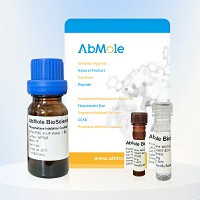All AbMole products are for research use only, cannot be used for human consumption.

PBP10 is a 10-AA peptide with rhodamine conjugated at its N terminus, exerts bactericidal activity against gram-positive and gram-negative bacteria and limits microbial-induced inflammatory effects. PBP10 is also a cell permeable and selective gelsolin-derived peptide inhibitor of formyl peptide receptor 2 (FPR2) over FPR1.
Sequence: RhB-Gln-Arg-Leu-Phe-Gln-Val-Lys-Gly-Arg-Arg-OH
| Molecular Weight | 1827.08 |
| Formula | C86H128F3N24O17 |
| CAS Number | 794466-43-6 (free base) |
| Storage |
Powder -20°C 3 years ; 4°C 2 years In solvent -80°C 6 months ; -20°C 1 month |
| Related FPR Products |
|---|
| Ac9-25
Ac9-25, a N-terminal peptide of Annexin I, acts as a formyl peptide receptor (FPR) agonist and activates the neutrophil NADPH oxidase through FPR. |
| N-Formyl-Nle-Leu-Phe-Nle-Tyr-Lys
N-Formyl-Nle-Leu-Phe-Nle-Tyr-Lys TFA (For-Nle-Leu-Phe-Nle-Tyr-Lys-OH TFA) is a formyl peptide receptor (FPR) agonist. |
| WKYMVM-NH2 TFA
WKYMVM-NH2 TFA is a potent N-formyl peptide receptor (FPR1) and FPRL1/2 agonist, also activates several leukocyte effector functions. |
| {Boc}-Phe-Leu-Phe-Leu-Phe
{Boc}-Phe-Leu-Phe-Leu-Phe ({Boc}-FLFLF) is a formyl peptide receptor (FPR) family antagonist that preferentially inhibits activity triggered through the formyl peptide receptor. |
| WKYMVM
WKYMVM is a potent N-formyl peptide receptor (FPR1) and FPRL1/2 agonist, also activates several leukocyte effector functions such as chemotaxis, mobilization of complement receptor-3, and activation of the NADPH oxidase. |
All AbMole products are for research use only, cannot be used for human consumption or veterinary use. We do not provide products or services to individuals. Please comply with the intended use and do not use AbMole products for any other purpose.


Products are for research use only. Not for human use. We do not sell to patients.
© Copyright 2010-2024 AbMole BioScience. All Rights Reserved.
